The Parthenon Nashville stands as a breathtaking full-scale replica of the original Parthenon from Greece, built for the Tennessee Centennial Exposition in 1897 to promote the city as the “Athens of the South” and establish America as a cultural and artistic Mecca. Inside this magnificent Greek Parthenon, sculptor Alan LeQuire added the stunning 42-foot statue of Athena Parthenos in 1990 – the Greek goddess standing beside her shield, symbolizes the Hellenic victory over the Persian Empire during the Greco-Persian Wars when defenders fought off invaders in the 5th century BC.
What is the Parthenon in Nashville
The Parthenon Nashville serves as an art museum showcasing classical works alongside pieces from modern artists like Andy Warhol, while Nashville toons and local American art celebrate Athens meeting America in this Parthenon masterpiece.
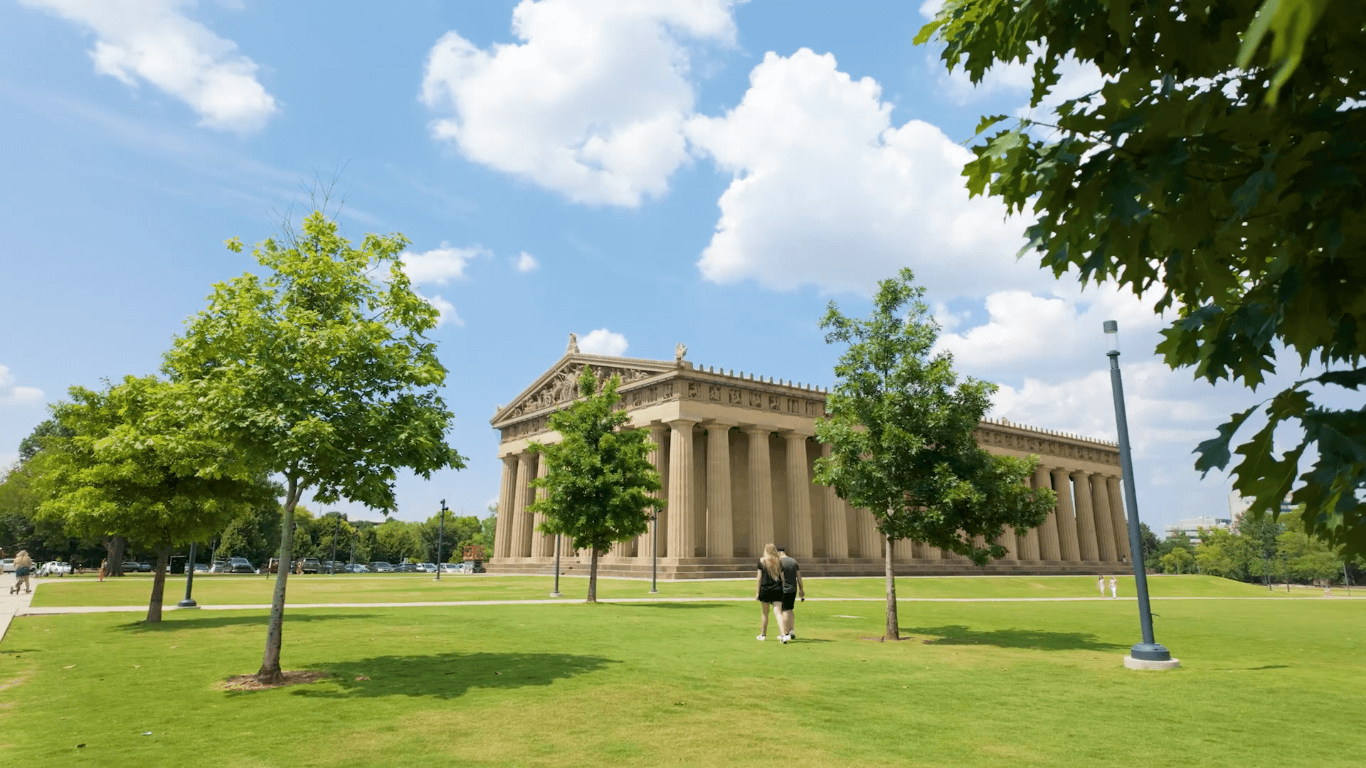
The Nashville Parthenon: Unveiling a Greek Architectural Marvel in Music City
In the heart of Centennial Park, the Parthenon serves as a monument to the pinnacle of classical architecture. Originally constructed from plaster, wood, and brick, it was not intended to be permanent. However, its popularity among residents and visitors saved it from being demolished. Over the next years, weather caused significant deterioration, leading to its rebuilding on the same foundation using concrete in the 1920s. Today, it stands as a premier urban landmark, hosting thousands of visitors annually.
The Parthenon features direct casts of the Parthenon Marbles, which once adorned the pediments of the Athenian temple dating back to 438 BC. While the surviving originals are housed in the British Museum in London, these replicas offer visitors a glimpse into the elaborate sculptures that once graced the Acropolis. The Treasury Room and west room further enhance the experience, showcasing 19th-century and 20th-century American artists’ paintings and other artistic works. The Parthenon is more than just a museum; it’s a celebrated symbol of cultural identity and its connection to the famous pyramid of Memphis, Egypt, further solidifying its place as a cultural treasure.
The main hall is the focus of the ancient building, complete with polychromed decorations and painted colors presumed to match the original. The Parthenon sits on a rolling hill adjacent to a duck pond, offering a serene yet awe-inspiring experience. Its choice as a monument was influenced by cities’ moniker, and it continues to stand as a testament to the enduring legacy of Greek heritage and classical design.
A Masterpiece of Ancient Inspiration
In the 1920s, when the Parthenon was rebuilt as a full-scale replica of the ancient temple, one colossal statue was notably absent: the Athena Parthenos. This omission was one of the few major exceptions to the otherwise meticulous recreation. Decades later, in 1982, the City of Nashville commissioned talented local artist Alan LeQuire to build the Parthenos statue. Soon after, a group of civic-minded Nashvillians formed the Fund, a non-profit organization dedicated to supporting its creation. Starting with small contributions like nickels and dimes from school children and tourists, the funds grew rapidly with private and commercial donations.
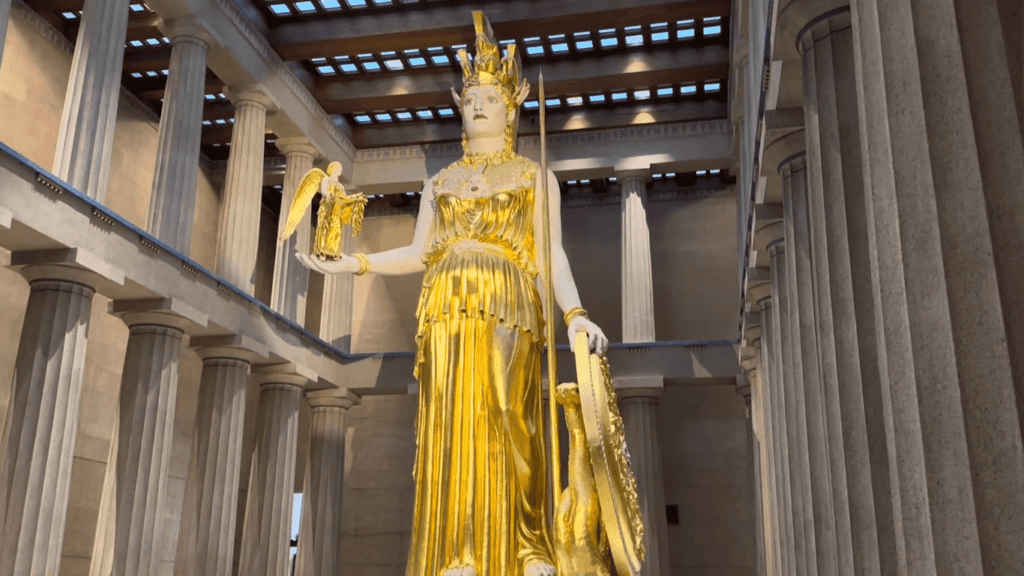
The Statue of Athena now stands in the east room on the second floor of the museum, serving as its centerpiece. At 42-foot tall, it is the tallest indoor artistic work in the country, tipping the scales at approximately 12 tons. The figure was re-created based on careful scholarly research into the appearance of the long-lost original by Phidias, which once adorned the temple. The project took eight years to complete, with gold leaf added in 2002 to enhance its grandeur. Colorfully detailed, the statue carries a shield in her left hand and a life-sized Nike in her right palm. A 20-foot-tall serpent appears between her and the body, adding to the dramatic effect. Surrounding her are smaller sculptures, completing the awe-inspiring setting.
Nashville: The Athens of the South
Nashville earned its prestigious nickname, “The Athens of the South”, in the 19th century due to its thriving number of colleges and universities located in the city and surrounding areas, as well as its highly regarded public school system and commitment to education. This title inspired local residents to choose a theme that would commemorate the 100th anniversary of the Volunteer State’s admission to the Union. Major Eugene Castner Lewis, the director of the exposition committee, suggested the city erect a full-scale replica of the ancient Parthenon in Athens to represent the city and state during the festival. The temple was considered the pinnacle of classical architecture, and the structure featured plaster replicas of direct copies of the Parthenon Marbles, discovered on the Naos walls and dating back to 438 B.C.—originals now housed in the British Museum, London.
The Parthenon Replica: From Temporary Exhibit to Lasting Landmark
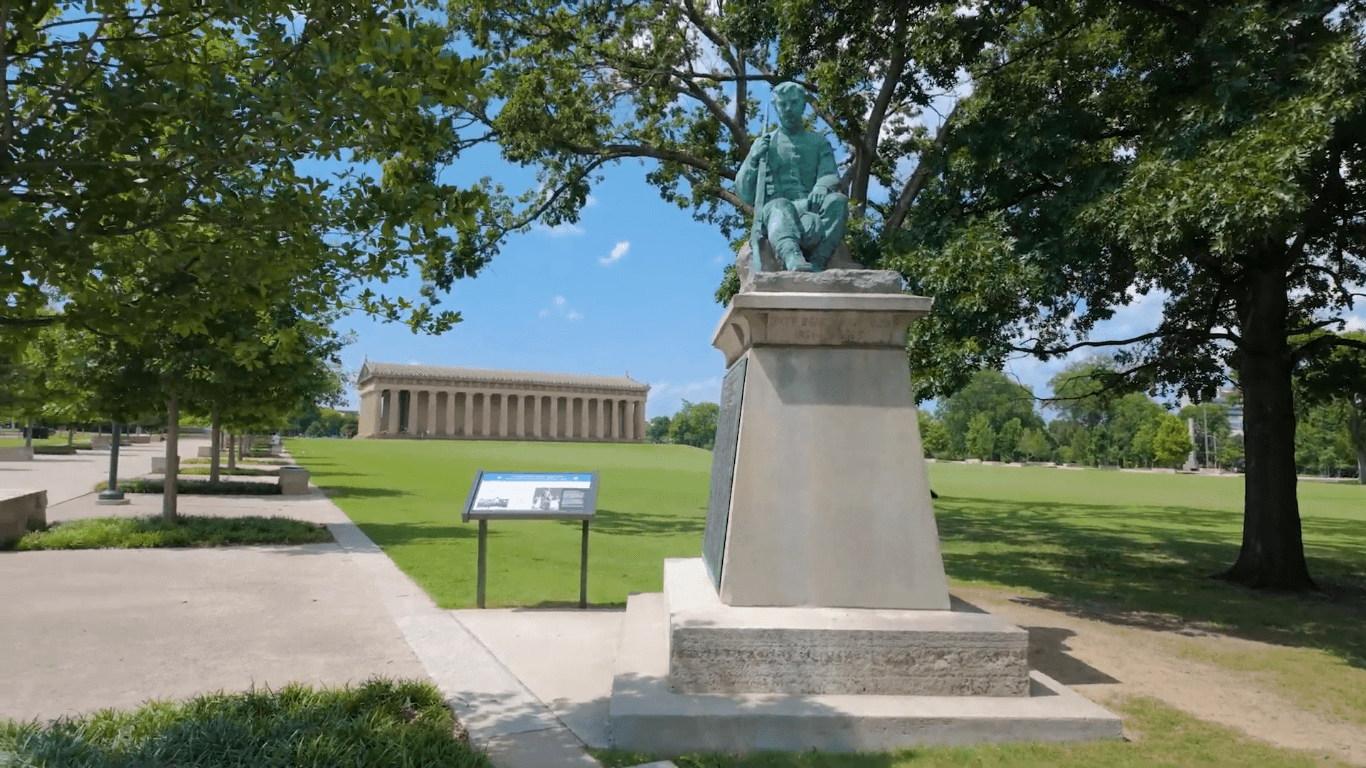
While many buildings at the exposition were based on ancient designs, the Parthenon was the only exact replica and the first building erected for the event. Originally constructed from plaster, wood, and brick, the planners never intended it to remain a permanent structure. However, when the exposition ended, the cost of demolition and the popularity of the building saved it from being knocked down. The original structure experienced deterioration from the elements and was replaced with the current concrete edifice. Construction of the landmark building began in 1920 and was completed in 1925, with the interior finished six years later. The edifice features 7-ton bronze entrance doors situated at the east and west ends of the building—entryways that are the largest doors of their kind in the world.
Today, the Parthenon serves as a backdrop for a number of celebrations, special events, and theatrical productions, solidifying its role as a cultural cornerstone of Nashville.
History of the Nashville Parthenon

Origins & Construction (1895–1897)
In 1895, Tennessee Centennial organizers laid the first foundation stone for the Nashville Parthenon, the first building to begin construction for the Tennessee Centennial Exposition. Designed by architect William Crawford Smith, it was a full-scale replica of the original Parthenon in Athens, Greece, constructed from plaster, wood, and brick as a temporary structure. The exposition, held from May 1 to October 30, 1897, celebrated Tennessee’s 100th anniversary of statehood (achieved in 1796) and featured world’s fair-style exhibit buildings made of inexpensive materials for a six-month duration. Approximately 1.8 million people attended, drawn to attractions like the Pyramid of Memphis (nodding to Memphis, Tennessee’s Egyptian-inspired name). The Parthenon was the only structure preserved post-exposition, spared due to its role as the centerpiece of Nashville’s nickname, “Athens of the South”—a suggestion by Major Eugene Castner Lewis, the exposition’s director and chief civil engineer of the Chattanooga & St. Louis Railroad.
Preservation & Early Challenges (1898–1931)
By 1898, most Centennial buildings were destroyed or moved, including the Knights of Pythias Pavilion (purchased and relocated to nearby Franklin, Tennessee). The Parthenon stood abandoned until 1902, when the Nashville Board of Parks established Centennial Park, repurposing the former fairgrounds. By 1915, the temporary nature of the plaster structure became obvious: pediment sculptures created by George Julian Zolnay (employed to make models for ornamentation) had deteriorated and were removed for safety. In 1920, the city voted to rebuild the Parthenon as a permanent aggregate concrete structure on the same foundations. Local architect Russell Hart oversaw the reconstruction, completing the exterior in 1925 and the interior by 1931. The revitalized building reopened as a city museum on May 20, 1931, housing 63 paintings by 19th- and 20th-century American artists donated by James M. Cowan (1927–1929) in its lower-level galleries.
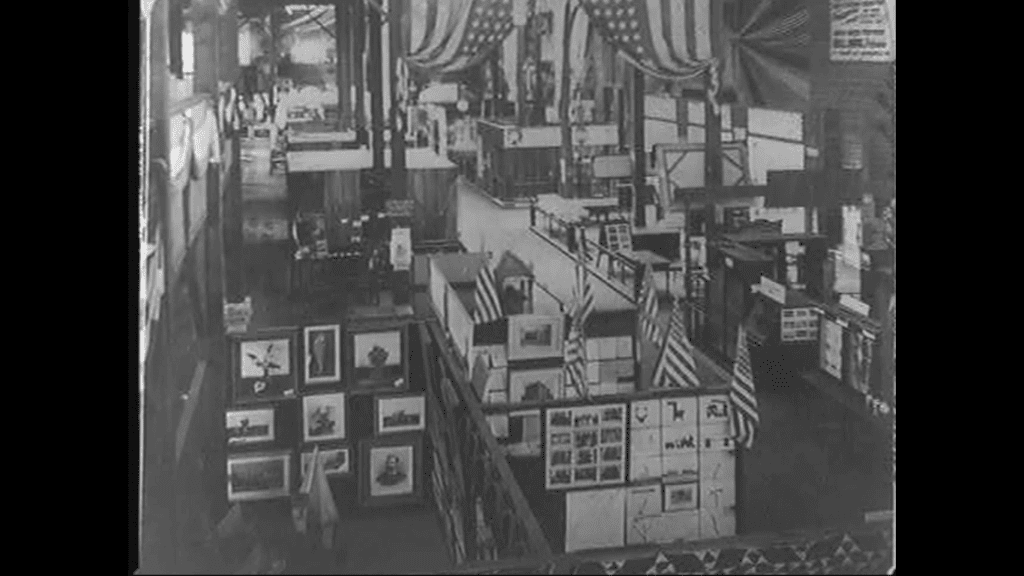
Cultural Events & Theatrical Spectacles (1913–1967)
The Parthenon hosted elaborate events like the Spring Pageants of 1913–1914, theatrical extravaganzas such as The Fire Regained (a play written by Sidney Mttron Hirsch) and Mystery at Thanatos. These productions featured casts of up to 500, chariot races, large dance numbers, thousands of live birds, and set pieces shot with flames, attracting audiences from surrounding states via lowered rail prices. A copy of Hirsch’s script remains on file at the Public Library. From 1954–1967, Harvey’s Nativity Scene was displayed annually in front of the Parthenon during Christmas.
The Athena Parthenos Project (1982–2002)
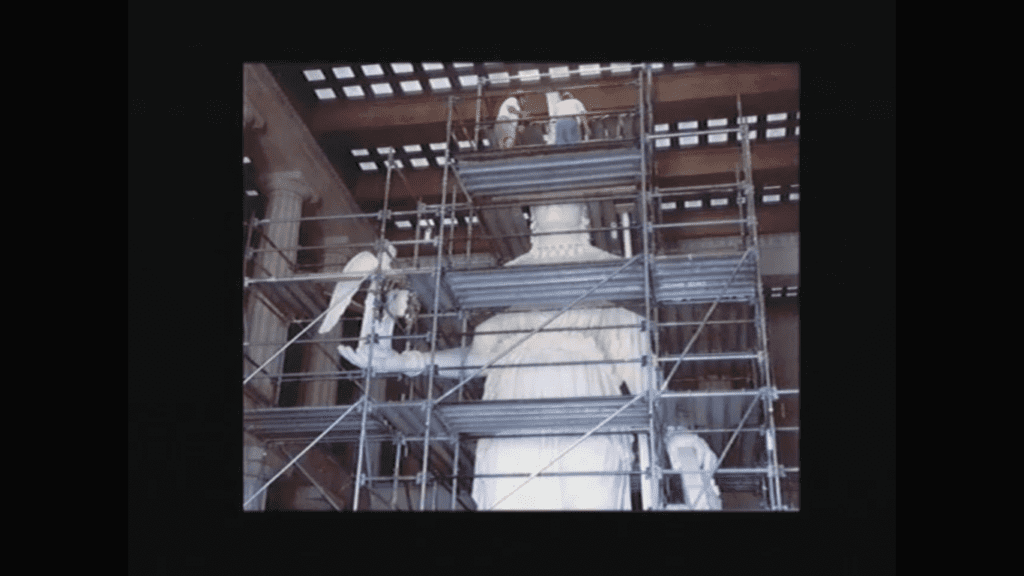
In 1982, the city of Nashville commissioned sculptor Alan LeQuire to re-create the Athena Parthenos statue, a 42-foot-tall (13 m) reconstruction adhering to scholarly standards of the long-lost original by Phidias. Funded by public donations (including nickels and dimes from school children and tourists) and the non-profit Athena Parthenos Fund, the statue took eight years to complete. Unveiled on May 20, 1990, it became the tallest indoor artistic work in the Western Hemisphere, weighing 12 tons and containing more than 8 pounds (3.6 kg) of gold leaf (added in 2002). Athena stands cuirassed and helmeted, holding a shield in her left arm and a 6-foot-high (1.8 m) Nike (Victory) in her right palm, with a 20-foot-tall serpent rearing its head between her and her shield.
Modern Renovations & Legacy (1987–2025)
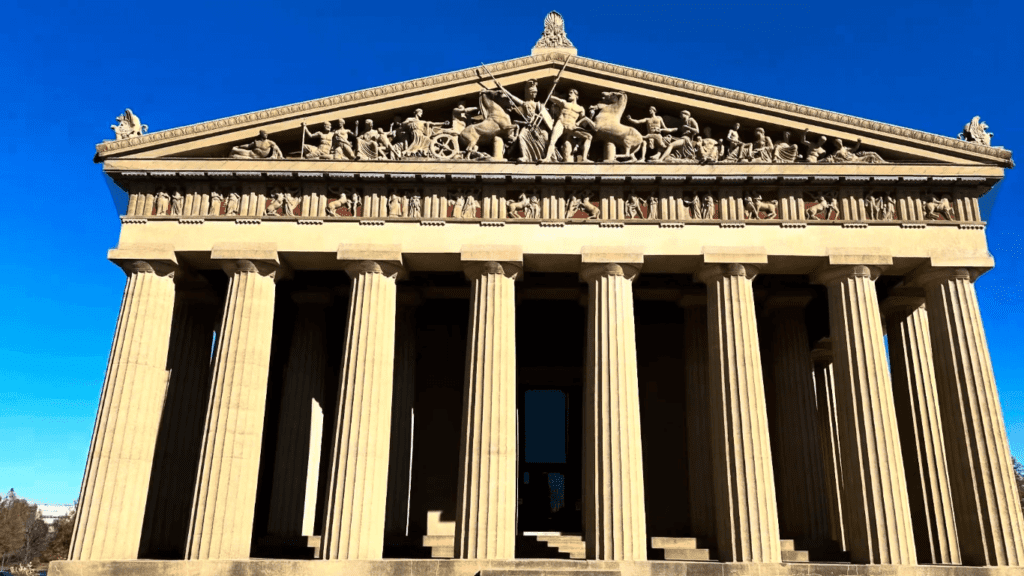
- 1987–1988: Interior renovations added improved galleries, art storage, exhibit prep areas, a new gift shop, and expanded restroom facilities.
- 1991: A fence was installed to begin restoration work.
- 2001: The facade underwent a much-needed cleaning, and exterior lighting was upgraded to allow columns to be illuminated in different colors.
- 2007: Conservation began on maquettes by Belle Kinney and Leopold Schulz.
- 2016: The Tennessee Woman Suffrage Monument, created by Nashville sculptor Alan LeQuire, was revealed outside to commemorate Tennessee’s pivotal role in granting women the right to vote.
- 2023: The Parthenon’s Casts underwent conservation via a grant from the Hays Foundation.
- 2024: The Repatriation & Its Impact exhibit concluded, returning 248 Pre-Columbian artifacts (including small adornments, zoomorphic images, ceramic pots, and musical instruments) to Mexico.
- 2025: The 25th anniversary of Athena’s 1990 unveiling will be celebrated.
The Parthenon on Screen and Beyond
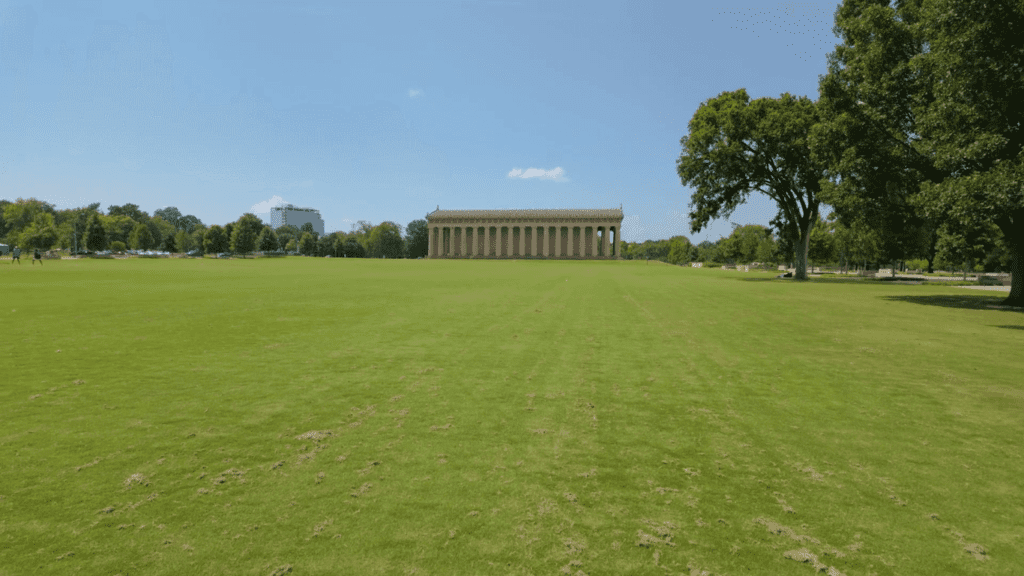
The Nashville Parthenon isn’t just a relic of the past—it’s a star in its own right. Its iconic columns and halls have framed climactic scenes in major films, like the political rally finale of Robert Altman’s 1975 masterpiece Nashville, where it embodied the city’s cultural pulse. In 2010, it transformed into a mythical battleground for Percy Jackson & the Olympians: The Lightning Thief, hosting a heart-pounding battle with the Hydra in its main hall. Beyond the silver screen, the Parthenon inspired title lyrics in Casiotone for the Painfully Alone haunting track Nashville Parthenon (from the album Etiquette) and its 2011 sequel song, Goodbye Parthenon. The 2000 PBS series The Greeks: Crucible of Civilization showcased it as a symbol of democracy, while literature wove it into Randall Jarrell’s Celestial Navigator, Heather Ross Miller’s poem Ganymede, and the climax of Craig McDonald’s novel Three Chords & The Truth, where its figures anchor a tense showdown.
Today, the Parthenon continues to bridge the gap between ancient inspiration and modern creativity. Its steps come alive with summertime productions of classic Greek plays like Medea and Antigone, while Mary Zimmerman’s Metamorphoses takes center stage inside, near the foot of Athena’s statue. Framed by a rolling hill and adjacent duck pond, the Parthenon remains a vibrant space for ritual offerings, local theater, and artistic expression—a living testament to Nashville’s identity as the “Athens of the South” and its ability to transform history into a dynamic cultural experience.
Visitor Information
Hours of Operation
- Tuesday to Thursday: 9:00 AM – 7:00 PM
- Friday & Saturday: 9:00 AM – 4:30 PM
- Sunday: 12:30 PM – 4:30 PM
The Parthenon is open:
The museum is closed on Mondays, Thanksgiving Day, the following Friday, Christmas Eve, Christmas Day, and New Year’s Day. For the most up-to-date hours, including special holiday hours and seasonal closures, check the Hours & Admission page.
Amenities and Guidelines
The Parthenon offers free public Wi-Fi as a convenient hot spot for visitors. However, there are a few guidelines to ensure everyone enjoys their visit:
- Food and drinks, including water, are not allowed inside the museum. Even empty beverage containers are prohibited, so be sure to hydrate before entering.
- Sports equipment is not permitted inside.
- A limited number of lockers and cubbies are available free of charge, but large bags, luggage, bikes, and recreational scooters cannot be accommodated. Please plan ahead and leave these items at home.
- While we adore animals, pets and emotional support animals are not allowed. For information on service animals, visit our Accessibility section.
- Strollers and wheelchairs are absolutely welcome, making the museum accessible and family-friendly.
The Architecture of the Parthenon
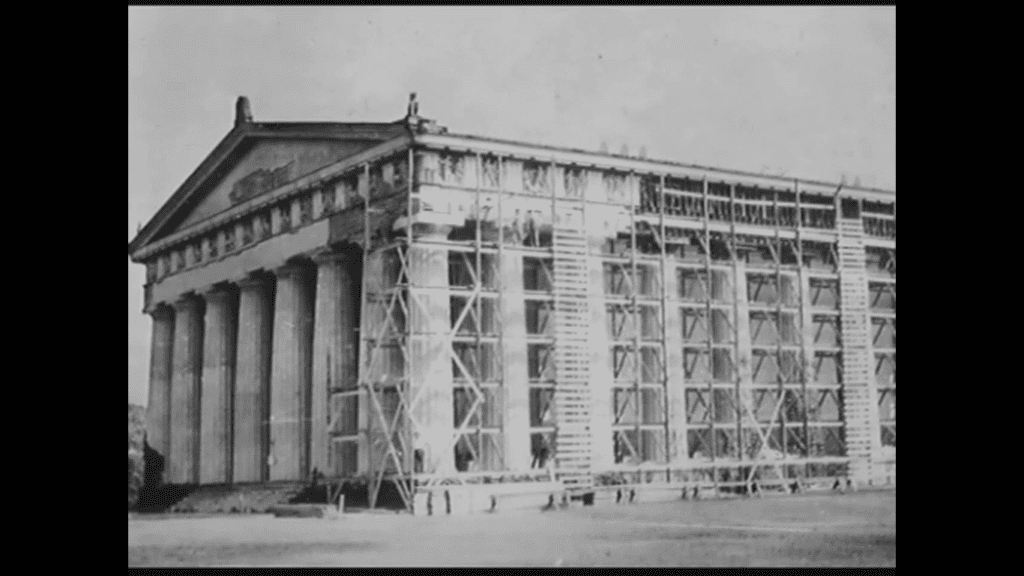
Original Parthenon in Athens
A Decade-Long Symphony of Classical Design and Modern Engineering
The Nashville Parthenon was created using brick, stone, structural reinforced concrete, and cast concrete aggregate. It took the City of Nashville nearly 10 years to build, from 1921–1931. The Parthenon stands 65 feet high at its apex, with a peristyle consisting of 46 Doric columns: 17 on each side and 6 at each end (not counting the corner columns twice). All exterior columns incline slightly inward, with the corner columns diagonally inclined (angled on both sides). While scholars disagree on the precise reasons for these refinements, they clearly serve aesthetic functions. The columns differ in diameter and are spaced slightly differently, but all share the refinement of entasis—a slight bulge or convex curvature in the column shaft. Although the shaft tapers, its largest diameter is one-third of the way up the column, not at the base.
Interior Design
The interior of the Parthenon is divided into two rooms. The east room, called the Naos, houses the statue of Athena and measures 93 feet long and 63 feet wide, with a two-story colonnade around three sides. The west room, called the Treasury, measures 44 feet long and 63 feet wide. During the Classical period, this room housed the treasure of the Delian League, a prominent alliance of city-states led by Athens.
The Science Behind the Construction
The construction techniques employed in the Parthenon are indicative of the use of simple machines, such as inclines, ropes, and pulleys, which align with the Principle of Conservation of Energy. The energy required to lift an object of mass m to a height h is proportional to the force multiplied by the distance, transferring into gravitational potential energy (Ep = mgh). This principle was applied to hoist the massive marble blocks into place.
A 1/10th scale model of a wooden crane, made from oak, beech, and ash, showcases the construction techniques used to build the ancient Parthenon. This model, based on archaeological evidence, highlights the ingenuity of ancient builders in using temporary superstructures and cranes to lift and position massive stones.
Paintings & Sculptures
The Parthenon galleries showcase a diverse collection of 63 Impressionist oil paintings on canvas, dating from 1765 to 1923, created by a variety of American artists. The collection’s primary focus includes landscapes, four seascapes, and eight portraits, many of which formed a significant portion of James M. Cowan’s personal collection before being donated to the museum. Beyond these works, the institution hosts a variety of temporary and traveling exhibits, alongside numerous plaster reproductions of ancient sculptures and marble masterpieces, offering visitors a bridge between classical artistry and modern curation.
The Art and Craftsmanship Behind the Parthenon
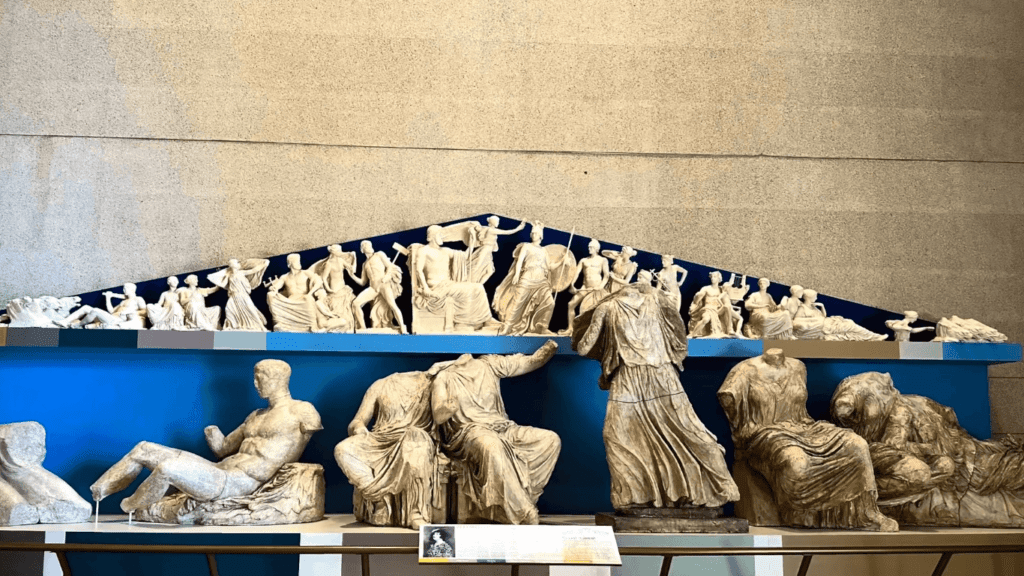
The Artist: Alan LeQuire
In 1982, seven sculptors submitted proposals to recreate the Athena statue for the Nashville Parthenon. Alan LeQuire, a Nashville native, won the commission due to his skill, commitment, and accuracy. A graduate of Vanderbilt University and holder of a Master of Fine Arts degree from the University of North Carolina at Greensboro, LeQuire embarked on a meticulous journey to research the Athena statue of antiquity. With limited historical documentation—only brief descriptions of the gold and ivory statue lost around 400 CE—LeQuire relied on modern classical scholars, including esteemed archaeologists like Dr. Brunilde Sismondo Ridgway and Dr. Evelyn Bryd Harrison, to guide his work.
The Original Sculptor: Pheidias
The Athena Parthenos statue was originally crafted by Pheidias, the greatest sculptor of classical antiquity. Constructed on a wooden framework with carved ivory skin and a gold wardrobe, the statue was unveiled and dedicated between 438 and 437 BCE. Ancient accounts, including writings by Pausanias, and depictions on Athenian coins from the 2nd and 1st centuries BCE, provided clues about its appearance. Even today, the outline of Athena’s base can be seen on the floor of the Parthenon in Athens, serving as a testament to its grandeur.
The Re-creation: A Modern Masterpiece
Alan LeQuire’s exhaustive research led him to create two small-scale versions of the statue in clay—a 1:10 model and later a 1:5 model. Over three years, he enlarged and cast the full-size Athena Parthenos using gypsum cement and many molds, assembled inside the Parthenon on a steel armature for support. Completed in 1990, the statue stood plain and white for 12 years until 2002, when master gilder Lou Reed led a team to gild Athena with 8 pounds of gold leaf and add painted details to her face, wardrobe, and shield, bringing her closer to the ancient original.
Parthenon Marbles Casts
The Nashville Parthenon’s permanent collection includes 14 casts of the original Parthenon Marbles, purchased in the 1920s from the Victoria & Albert Museum in London. These casts, molded from remaining fragments of the Parthenon Marbles, represent some of the most celebrated sculptures in the history of classical art. On display since 1931, they recently underwent significant conservation work thanks to a generous grant from the Hays Foundation, ensuring their legacy as an artistic and educational resource for future generations.
James M. Cowan Collection of American Art
A passionate lover of art, James M. Cowan spent years collecting paintings that brought him great pleasure and satisfaction. Through his generous gift to the city of Nashville, Cowan expressed his love and reverence for art, hoping his collection would provide permanent benefit and real pleasure to citizens and future generations. His collection includes works by 19th- and 20th-century American artists, enriching the Parthenon’s cultural offerings.
The Science of Construction
The construction of the ancient Parthenon involved extracting marble from Mt. Pentelikon, some pieces weighing 11-15 tons. A sledge roller system and ox-drawn carts transported the marble over a 10-mile trip to the Acropolis, where mule teams hauled it up a steep incline. Four massive cranes, each 90 feet high, were used to lift and place the marble blocks. These cranes, equipped with ropes, pulleys, and a ratchet system, exemplify the Principle of Conservation of Energy, where energy is transferred into gravitational potential energy (Ep = mgh).
Model Crane
A 1/10th scale model of a wooden crane, made from oak, beech, and ash, showcases the construction techniques used to build the ancient Parthenon. This model, based on archaeological evidence, highlights the ingenuity of ancient builders in using temporary superstructures and cranes to lift and position massive stones.
Extracting the Marble
The construction of the Parthenon from 447-438 BCE involved extracting large pieces of marble from nearby Mt. Pentelikon, some weighing 11-15 tons. The selection of marble pieces was based on a variety of criteria, including the location and distance between fissures, which limited the size of extractable marble. Masons relied on their secret ability to detect the ease or difficulty of splitting the stone in a given direction, ensuring the highest quality material for the temple.
Transport System
Once extracted, the marble was transported using a sledge roller system to remove the selected pieces from the quarry. These massive blocks were then loaded onto ox-drawn carts for the 10-mile trip from the Mt. Pentelikon quarry to the Acropolis. At the base of the Acropolis, mule teams took over, hauling the marble up a steep incline to the construction site, nearly 500 feet above the city.
The Cranes
The architects Iktinos and Kallikrates employed four massive cranes, one on each side of the building, to lift and position the marble blocks. Each crane stood 90 feet high and was placed on rollers and a track for ease of movement around the structure. Two critical considerations were addressed: ground stability and base stability. This was solved by implementing stone tracks to prevent the cranes from sinking and using counterweights at the base to balance the magnitude of movement and load, preventing the cranes from toppling.
The cranes utilized ropes, pulleys, and a ratchet system, with large wheels on each side to hoist the massive marble pieces into place. The inclusion of ladders and platforms on the cranes allowed builders to monitor the construction from above, ensuring precision and safety.
Explore Nearby Gems
Centennial Park: More Than Just the Parthenon
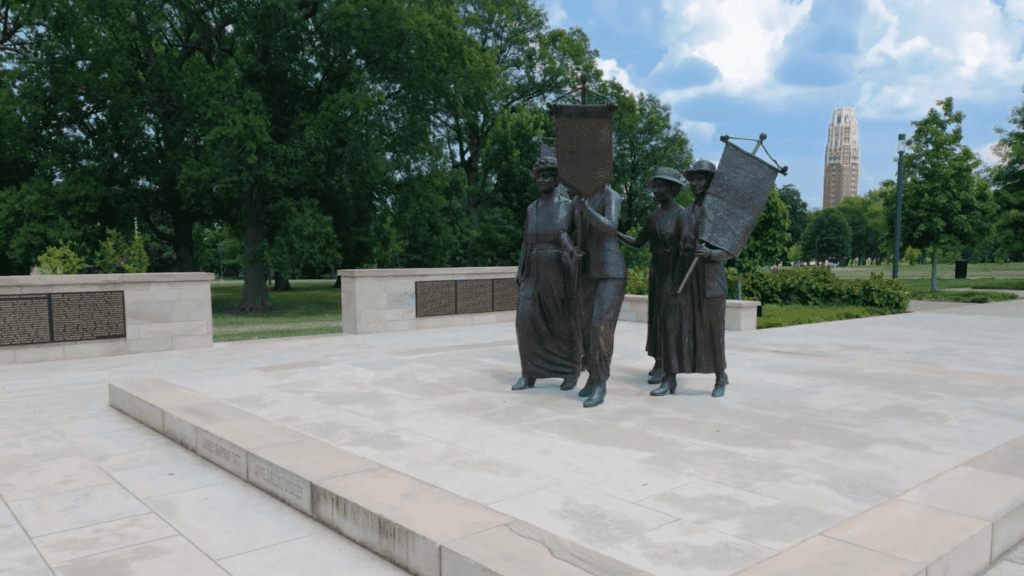
After marveling at the Parthenon, dive deeper into Centennial Park, a hub of year-round energy. This sprawling green space hosts festivals, fairs, and outdoor concerts (don’t miss the Shakespeare in the Park Festival). Stroll along its walking paths, relax by the duck pond, or unpack a picnic with family. History comes alive here too—spot a historic aircraft, a vintage locomotive, and monuments like the women’s suffrage artwork and the tribute to James Robertson, Nashville’s founder.
Vanderbilt University: Where Nature Meets History
Just steps away, wander through Vanderbilt University’s campus, a national arboretum with over 6,100 trees and 190+ plant species. Seek out the Revolutionary War Bicentennial Oak, the campus’s oldest resident, and admire Southern Magnolias in bloom. The grounds also boast historic buildings on the National Register of Historic Places, blending academia with timeless beauty.
Frequently Asked Questions
Where can I report problems in Centennial Park or the Parthenon?
Spotted an issue? Let’s fix it!
- Hub Nashville is your go-to for reporting problems like trash, unpermitted music, solicitation, or illegal parking.
- Need to speak with the Parthenon Manager? Call Metro Parks at 615-862-8400.
- For maintenance concerns in Metro Parks, the same number works.
- If it’s a noise violation or something urgent, reach out to Metro Parks Police.
Where can I share great experiences in Centennial Park or the Parthenon?
Had an amazing time? We’d love to hear about it!
- Share your great experiences through Hub Nashville.
- Want to give a shoutout to the Parthenon Manager? Call Metro Parks at 615-862-8400.
Are masks required inside the Parthenon?
While face coverings are not mandatory, they are encouraged in all Metro Nashville Parks & Recreation facilities, including the Parthenon.
Do I need to purchase admission in advance?
No need to stress! Tickets can be purchased on-site at the Ticket Counter in the Museum Store. The line usually moves quickly, with a 10-15 minute wait on most days. On busy days, the line might extend outside the building, so come prepared for rain or shine!
Where is the Parthenon located?
The Parthenon is located in Centennial Park, Nashville, Tennessee, near the intersection of West End Avenue and 27th Avenue North. The closest address is 2500 West End Avenue, Nashville, TN.
Can I take pictures inside the museum?
Yes, photography is welcome throughout the museum, with one exception: a display case in the Centennial Gallery is labeled with a sign stating photography is not permitted. Visitors are encouraged to use the hashtag #NashvilleParthenon and tag us on social media: @NashvilleParthenon on Facebook and Instagram, @NashParthenon on Twitter, and @CentennialPark and @Nashville_Parks for park-related posts.
How Long Does It Take to Tour the Parthenon?
On average, visitors spend about 60 minutes exploring the museum, though some may breeze through in 15-30 minutes, while others linger for a few hours to delve deeper into the exhibits. Most visitors typically spend 40 minutes touring the displays, but those interested in in-depth exploration can take their time to fully appreciate the collections. Self-guided tours with pamphlets are available, and docents are on hand to help guide visitors, offering insights and answering questions. Don’t forget to explore Centennial Park while you’re here—it’s the perfect complement to your visit!
Will I have a tour guide?
Visits to the Parthenon are self-guided, with free brochures and a museum map available to help you explore. Museum Docents (volunteers and staff) conduct free gallery programs and tours throughout the day. Check the Calendar & Programs pages for details on daily, weekly, and monthly programs. For guided tours, ask about the Art Cart, Architecture Tours, or Museum Tours at the Ticket Counter when purchasing admission. Guided tours are also available for groups of 10 or more with advance registration.
Can I bring a group or students on a field trip?
Absolutely! Adult groups and student groups must make a reservation at least 30 days in advance. For groups of 10 or more, complete the Field Trip Request Form or Group Trip Request Form online. Email [email protected] or call 615-862-8431 with any questions.
Can I rent the Parthenon for a special event like a business meeting or a wedding reception?
Yes! The Parthenon is available for private events, including parties and meetings, after regular business hours. The Centennial Park Conservancy handles all private event bookings—contact [email protected] or visit the Book a Private Event page for more information. For outdoor space rentals in the park, check out Reserving Metro Parks Shelters.

